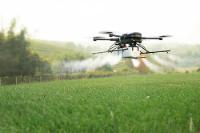Agricultural pesticides and biocides
Managing the risks from the use of drones for pesticide applications
 The use of drones or Unpersonned Aerial Vehicles (UAV) for the application of crop protection products in certain countries or regions is expanding significantly, and there is a rapid evolution in this area.
The use of drones or Unpersonned Aerial Vehicles (UAV) for the application of crop protection products in certain countries or regions is expanding significantly, and there is a rapid evolution in this area.
Unmanned Aerial Spray Systems (UASS) have the potential to provide benefits that could contribute to the more sustainable use of pesticides such as reduction of applicator exposure in comparison to backpack spraying, better quality applications in difficult to access scenarios, and the enablement of precise zone or spot application.
There are a number of challenges in part due to a lack of understanding of these technologies. These include spray drift, operator exposure, operator training, and formulation technology for drone-based applications.
OECD member countries are addressing these challenges under the OECD Pesticide Programme
The OECD published the Report on the State of the Knowledge – Literature Review on Unmanned Aerial Spray Systems (UASS) in Agriculture, Series on Pesticides, No. 105 on 3 November 2021. This thematic review defines aspects of Unmanned Aerial Spray Systems (UASS) technology that influence the risk characteristics in comparison with existing pesticide product evaluations. The Report also identifies additional work needed to support the development of guidance for the regulatory risk assessment and decision processes for UASS application of pesticides.
The next step must be to carry out work aimed at filling the identified gaps to develop new UASS focused models for use in regulatory approval processes, and this will require greater engagement with those bodies and organisations which create and provide such data.
This work can also promote harmonisation of risk assessment approaches across countries.
Understanding the regulatory implications of new digital and mechanical technologies for the application of pesticides
This effort was initiated as a recommendation of the OECD Risk Reduction Seminar on Evolving Digital and Mechanical Technologies for Pesticides and Pest Management on 26 June 2019. The seminar provided an opportunity for experts in OECD governments and stakeholders to share their knowledge, experience and possible concerns associated with new mechanical and digital evolving technologies, focusing on technologies such as precision agriculture machinery, data collection, and data processing. The Report of the OECD Risk Reduction Seminar on Evolving Digital and Mechanical Technologies for Pesticides and Pest Management summarises the discussions and outcomes of the Seminar.
ENGAGE WITH US
- To receive our latest news, publications and events, sign up to the Chemical Safety and Biotechnology Update newsletters.
- Contact: ehs.contact@oecd.org
- Stay tuned on Twitter: @OECD_ENV
- Watch our videos on our YouTube channel
Related Documents